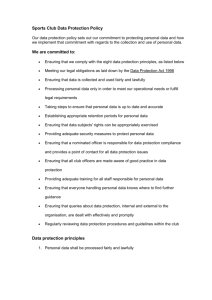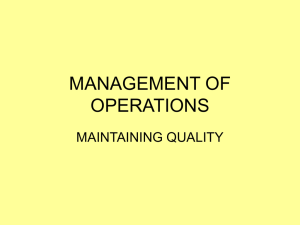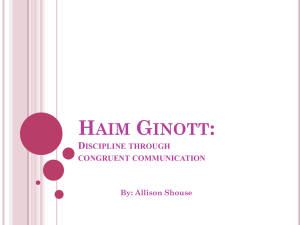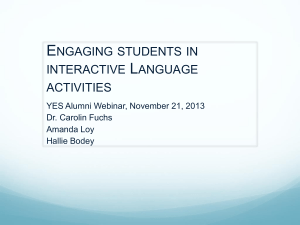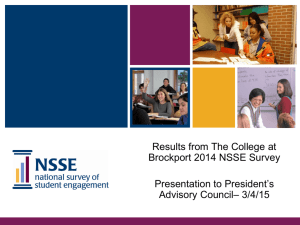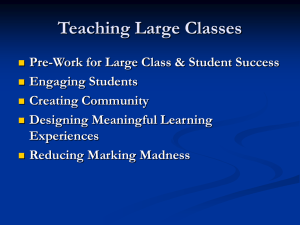engagement - Lancaster University
advertisement
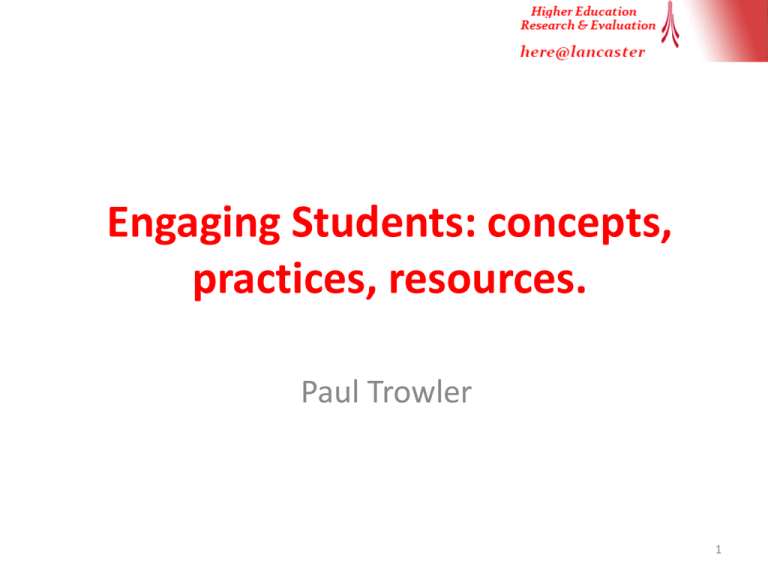
Engaging Students: concepts, practices, resources. Paul Trowler 1 Conceptualising engagement • Student engagement has behavioural, cognitive and affective dimensions, with congruent (conforming) and oppositional (rebellious or innovative) manifestations of each of these. • Our working definition, based on the literature, states that: Student engagement is the investment of time, effort and other relevant resources by both students and their institutions intended to optimise the student experience and enhance the learning outcomes and development of students, and the performance and reputation of the institution. 2 3 foci..... • Individual Student Learning • Structure and Process • Identity 3 3 axes 4 “Congruent” engagement (conformity) Behavioural Attends Non-engagement “Oppositional” engagement (rebellion, innovation) lectures, Skips lectures without Boycotts, participates with excuse pickets or disrupts lectures enthusiasm Emotional Interest Cognitive Meets Boredom or assignment exceeds Assignments rushed or absent Rejection late, Redefines parameters for assignments requirements 5 Please see handout ….. and offer your comments on it 6 What’s missing • http://www.pedagogicequality.ac.uk/ Ashwin, P., McLean, M., and Abbas, A. (2012) Quality and Inequality in Undergraduate Courses: A guide for national and institutional policy makers. Nottingham: University of Nottingham. 7 Educational ideology • Market Model of Student Engagement (MMSE) (http://www.pedagogicequality.ac.uk/timeline.php#workingpapers) • Developmental Model of Student Engagement (DMSE). (there is also a social reconstructionist model and a traditionalist model) Difficult to move all the way along May’s Stages of Engagement for each of these under the MMSE: Consultation – Involvement – Participation - Partnership 8 Engagement for what? • • • • Engagement to improve learning Engagement for curricular relevance Engagement for democratisation and participation Engagement for equality / social justice / inclusivity • • • • Engagement to improve throughput rates and retention Engagement for institutional benefit Engagement as marketing Engagement for value-for-money 9 Some pointers.... The DEEP Project (Documenting Effective Educational Practices) – a collaboration between the National Survey of Student Engagement and the American Association for Higher Education) (Kezar 2005: 2-4) documents leadership characteristics common across engaged / engaging institutions, such as • Developing a shared understanding of institutional mission and philosophy; • Building a strong sense of community; • Modelling collaboration and distributed leadership through shared governance; • Ensuring that students have a prominent voice in campus governance; • Adopting structures which encourage cross-functional activities focussed on student success; • Tightening the philosophical and operational linkages between academic and student affairs; • Empowering and supporting academic leadership; • Creating and capitalising on cross-functional, boundary-spanning 10 activities. The Leadership Foundation Study.... Engagement Champions in senior roles......(empowering and supporting leadership) “The opportunity for students to have a voice, to be co-producers in all aspects of their education and the university and its wider community… is something we’ve been focused on as the students union for a long time, but I must say since the arrival of [the current VC] we’ve had a real commitment. We have had a commitment from senior leadership prior to that, but it tended to be solely in the area of the academic experience… We’re in a fantastic position now and the university is really committed to making sure the student voice is heard.” (Student Leader) 11 The Leadership Foundation Study.... Building community and shared understandings... “Most of that is about inspiring engagement, by people to an extent seeing that it’s about partnership. It may start with respect and develop into something more jointly owned. I think often it starts with a power relationship and then it builds into something which is much more equal. (Senior Manager)” 12 Different agendas….. “What the University wants from [student engagement] is some instrumental things, a more satisfied student population as measured, it wants a more successful student population, so it wants a student population that loses less students, so it wants all of those instrumental measures of success. But increasingly the University recognises that the only way to get there is to achieve a more participative environment, a more supportive environment, a more positive environment… and thus for those things to emerge… …I’m saying to Deans and [other senior managers] the reason for going down this road of engaging with students and trying to an extent frame expectations but also meet expectations and create a more partnered environment is that it will help you achieve your financial bottom line because you’ll lose less students. S I think you can have people on the same journey for different motivations and I don’t think that matters particularly. What matters is the journey.” (Senior Manager) 13 Industrial relations metaphor…. I’ve spent a lot of my life involved in studying trade unions and the management of staff in universities and elsewhere, and there are parallel concepts of employee engagement and there are objects of trade union activism. It strikes me that all these things are about partnership and cooperation and working together. You can’t do it on your own. Students can’t be engaged on their own. They have to have someone willingly engaging with them. (Senior Leader) (Heckscher’s work: http://www.heckscher.com/) 14 Success factors 1… • Bringing student representatives onto all kinds of university structures, including those concerned with changes to systems, structures or processes (such as building project boards) in material ways – such as equal numbers of staff and students on programme committees. • GOAT (go out and talk) & GOAL (go out and listen) - speaking informally, and often, to leaders and representatives of other sectors (students, senior managers, staff leaders, etc), to gauge their feelings and views, and developing strong personal relationships based on mutual respect • Actively involving the university in students’ union activities • Ensuring that the student representative system is really representative of all constituencies within the student body, including “invisible” groups such as part-time students, student parents or students from elsewhere • Active student involvement in the selection of senior managers with a high level of personal commitment to student engagement – and then holding them accountable to this commitment 15 Success factors 2…. • Reviewing procedures to ensure that these don’t themselves give rise to problems or complaints, and lightening the bureaucratic load • “Closing the feedback loop” – ensuring that everybody sees the results and can celebrate the “wins” of engagement • For managers and staff, wanting to see things from students’ perspectives, and being genuinely committed to ensuring students have a positive experience at university • Shifting the official policies to reflect a genuine prioritisation of partnership and community, and the prioritisation of student engagement, and ensuring consistent messages from senior management • Not being A Manager – working against a “managerial” image to connect in a way that is meaningful to students / staff • Replacing a culture of compliance with a culture of permission, tolerating “mess” and uncertainty • Dogged persistence until the mindset and the culture change, so that collaborative approaches become automatic and can be self-sustaining • “Finding the right people” 16 Getting there: bridge metaphor ...allows specifics of starting place, for the environment, the climate, the terrain. “Journeys” are seldom simply unproblematic linear progressions from one point to another. Metaphor also permits the possibility of retreat back along one’s path, or for facilitating the passage of those who follow. 17 Need to think about • The three dimensions of student engagement….. • Where are we now on each of these and what do we want to change (and how)? 18 Bridge design.... • Salience (how important engagement initiatives are in relation to the many others coming at staff and students) • Congruence (how they fit in, or don’t, with current practices) • Profitability (how far current sets of interests and priorities are met, and how these can be altered) 19 Recommendations • Student engagement needs to be a thorough-going commitment throughout the university if it is to be sustainable. While pockets of “good practice” are useful for modelling and inspiring, without a genuine commitment from leaders in all sectors and at all levels of the university, student engagement runs the risk of being “the next big thing” shuffled off the agenda once something else comes along. • Student engagement has at its root mutual respect. Without trust, a willingness to share power in appropriate ways struggles against inhibition and reluctance. True partnership shares responsibility as well as authority. • Community matters. Beyond the partnership, the sense of belonging to something greater than one’s programme, one’s department or one’s university provides investment, involvement and purpose in an outwardfacing direction. • Students are inspired by staff who are inspired. Student engagement requires engaged staff – of all kinds. 20 Reflection… – Salience: how important is this student engagement initiative in your institution compared to other initiatives? – Congruence: Which of the approaches to student engagement do you wish to enhance in your institution? Is it the most congruent with the character of the place in terms of current practices? – Profitability: In what ways would these intended changes benefit the various groups involved: staff; students; managers? Would the benefits be obvious to them? If not, what might persuade them of these benefits? – What change strategies can you adopt that are likely to shift established practices in the desired direction? – Consider the success factors compared with the situation at your institution. What needs to be addressed? 21 Resources • Our HEA reports.... http://www.heacademy.ac.uk/resources/detail/studentengagement/Research_and_ev idence_base_for_student_engagement • Our LFHE Reports… http://www.lfhe.ac.uk/research/smallprojects/sdp2011successfulprojects.html • Sakai Engagement site: https://sakai.lancs.ac.uk (login with username: sakai.guest@gmail.com and password: welcome) • NUS Engagement toolkit: http://www.nusconnect.org.uk/campaigns/highereducation/studentengagement/toolkit/ • NSSE and AUSSE…….. http://nsse.iub.edu/ http://www.acer.edu.au/research/ausse • DEEP Project guides: http://nsse.iub.edu/_/?cid=128 • Paul Hamlyn Project Report: Building Student Engagement for Retention and Success 22 Our Leadership for Engagement Toolkit 23


